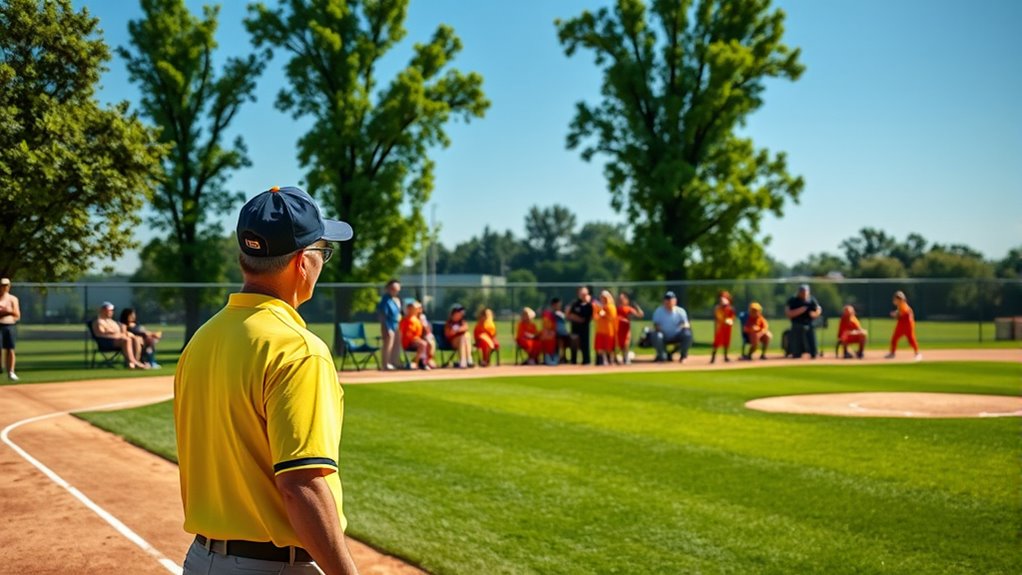On game day, understanding key softball rules and umpire signals helps you follow the action and support your player effectively. Recognize common signals like fists for strikes or pointing for outs, and observe player positions and movements to see how plays develop. Knowing the flow of the game and roles on the field makes it easier to cheer appropriately and stay engaged. Keep exploring to discover more tips that will enhance your game-day experience even further.
Key Takeaways
- Learn umpire signals to understand calls and communicate effectively during the game.
- Know player positions and field setup to follow game flow and strategic plays.
- Observe player movements to recognize plays like steals, double plays, and positional changes.
- Support players appropriately by understanding the game’s rules and respecting umpire decisions.
- Stay engaged by following game rules and signals, enhancing your understanding and enjoyment of the match.

As a parent, understanding the basic rules of softball can help you support your child’s team and enjoy the game more fully. One of the most important aspects to recognize is the role of umpire signals. Umpires use a variety of hand signals and body movements to communicate calls like balls, strikes, outs, and safe plays. Watching these signals closely can help you understand what’s happening on the field, especially when the game gets intense or noisy. For example, an umpire might raise a fist above their head to indicate a strike or point to the ground to call a safe or out. Learning these signals allows you to follow the game more accurately and cheer appropriately, without confusion. It’s also helpful to know the player positions, as they directly influence the gameplay and strategies on the field. In softball, players are typically arranged in specific positions: pitcher, catcher, first base, second base, third base, shortstop, and outfielders (left, center, right). Knowing where each player is supposed to be helps you understand the flow of the game. For instance, when a batter hits the ball, you’ll see players moving into their respective positions to field the ball or cover bases. Recognizing the pitcher’s role as the one throwing the ball to the batter and the catcher’s position behind home plate to catch pitches is also key. These roles are fundamental to understanding game dynamics and the importance of each play.
Additionally, understanding game flow and how players adapt their positions during different plays can enhance your overall enjoyment and support for the team. During the game, you’ll notice that players move quickly, and their positions may shift depending on the situation—like a double play attempt or a steal. Being familiar with these positions helps you follow the action and appreciate the skills involved. Additionally, understanding when players are expected to be in certain spots can help you cheer for good plays or encourage your child if they’re playing in a specific position. It’s good to remember that umpire signals are consistent across games, so once you learn what each one means, you’ll be able to follow calls more easily throughout the season. Supporting your child isn’t just about cheering; it’s also about understanding what’s happening on the field. Knowing the umpire signals and player positions makes it easier to stay engaged, respect the game’s flow, and enjoy watching your child’s team develop their skills and teamwork.
Frequently Asked Questions
How Do I Handle Disputes With Umpires During the Game?
When disputes arise with umpires during the game, stay calm and focus on effective umpire communication. Approach the umpire politely, express your concerns clearly, and listen carefully to their perspective. Remember, dispute resolution works best when you maintain respect and patience. Avoid arguing aggressively; instead, calmly seek clarification or ask if you can discuss the call after the inning. Your respectful attitude helps keep the game enjoyable for everyone involved.
What Should I Do if My Child Gets Injured on the Field?
When your child gets injured on the field, stay calm and quickly assess the situation. Your injury response and parental first aid are essential; provide gentle guidance, comfort, and care. Call for help if needed, and don’t forget to notify the coach or medical personnel. Show support and stay positive, helping your child feel safe and secure. Remember, patience and preparedness turn a tough moment into a teaching opportunity.
Are There Specific Rules for Cheering or Coaching From the Sidelines?
You should remember that sideline cheering is encouraged to support your child, but it’s important to stay within coaching boundaries. Avoid giving direct instructions or coaching from the sidelines, as it can confuse players and disrupt the game. Instead, cheer positively and encourage good sportsmanship. Respect the coach’s authority, and focus on creating a fun, supportive environment. Your enthusiasm can boost your child’s confidence without crossing any game day rules.
How Can I Best Support My Child’s Sportsmanship and Teamwork?
You can best support your child’s sportsmanship and teamwork by using positive reinforcement and modeling respectful communication. Cheer for their efforts, not just the outcomes, and encourage them to celebrate teammates’ successes. Show respect for coaches, officials, and opponents, and discuss the importance of teamwork off the field. Your supportive attitude helps your child develop a positive mindset, fostering good sportsmanship and strong team bonds.
What Are the Common Penalties Parents Should Be Aware of During Games?
During games, you should be aware of common penalties related to parent conduct and equipment safety. Avoid loud or disruptive behavior, as it can lead to warnings or ejections. Guarantee your child’s equipment is safe and properly fitted to prevent injuries. Stay positive, follow the rules, and support fair play. By maintaining respectful conduct and promoting safety, you help create a positive environment for players, officials, and fellow parents.
Conclusion
So, now you’re all set to cheer confidently, armed with rules and ready to support your player. Just remember, despite knowing the game inside out, you might still find yourself nervously clutching that foam finger or accidentally shouting the wrong call. Ironically, the more you learn, the more you realize how much chaos and unpredictability the game can throw at you. But hey, isn’t that what makes softball so wonderfully unpredictable? Enjoy every hilarious, heart-pounding moment!









